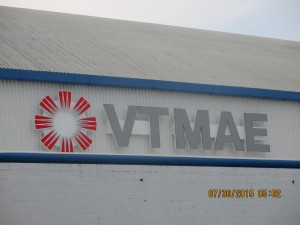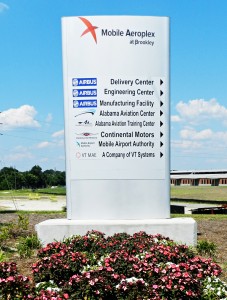Growth in cards for VT MAE
- August 12, 2015
- / David Tortorano
- / economy

The president of VT MAE, Bill Hafner, will tell you he’s “bullish” about the Gulf Coast Interstate 10 aerospace region, which he sees as primed for growth.
Indeed, his company has had a maintenance, repair and overhaul operation in Mobile, Ala., since 1991, and is in the midst of expanding into Pensacola with a 300-500 worker ninth hangar. If that’s not significant enough, Hafner said there’s already talk about a “Phase II” that would double the footprint with a second hangar at Pensacola International Airport.
“The region is primed. It really is looking good for growth,” said Hafner, who’s been president and chief operating officer at VT MAE since June 2014. He points to Airbus, which will be a big employer, and the supply chain it’s bringing to the region, as well as VT MAE’s growth.
Hafner expects groundbreaking in January 2016 for the 19-acre Pensacola operation. Between now and then, details about the large hangar are being hammered out.

In mid-July an $8 million contract was awarded to Phoenix Construction Services to expand the airport’s cargo apron and a $2.5 million contract was awarded to Atkins North America for architectural and engineering design for the MRO.
Hafner said the two-bay hangar in Pensacola is targeting narrow-body aircraft work. Like Mobile’s Hangar 7, it will be able to handle as many as four 757 or possibly six A320s. Informally called Hangar 9, it will be a remote location of the Mobile operation.
Hafner said that when it opens it will have 200 workers, then gear up to 300. With a three-year ramp up, it could have as many as 500 employees when fully operational, he said. The talked about Phase II would double the size of the operation with another two-bay hangar.
There may also more work in the cards for the Mobile operation. ST Aerospace in June signed a deal with Airbus to convert A320 and A321 jetliners into freighters. Airbus sees a need for more than 600 aircraft to be converted in the small freighter range over the next 20 years. The passenger-to-freighter (p2f) conversion work will be done at ST Aerospace's facilities globally, including the United States.
Mighty Singapore
For a relatively small country, Singapore has a large presence in the Gulf Coast thanks to powerhouse Singapore Technologies Engineering (ST Engineering). In addition to the Mobile and planned Pensacola MRO, it has a shipyard in Pascagoula, Miss.
Singapore is among the top 20 foreign investors in the United States. Its direct investment in the United States is some $23.5 billion, third largest from Southeast Asia after Japan and Australia, according to figures from Singapore.
Singapore is an island in Southeast Asia between Malaysia and Indonesia. It’s just over 265 square miles, a bit more than 3.5 times the size of Washington, D.C., and had an estimated population of 5.6 million in July 2014, according to the CIA Factbook.
Founded as a British trading colony, it joined the Malaysian Federation in 1963 but became independent two years later. It subsequently became one of the world’s most prosperous countries, a free-market economy with a per capita GDP equal to that of the leading nations of Western Europe.
Singapore, which celebrates its independence day Aug. 9, is important enough that in June U.S. Rep. Bradley Byrne, R-Ala., and Rep. Denny Heck, D-Wash., announced the restart of the dormant, bipartisan Singapore Caucus because of the economic and military ties.
“We have operations in Germany, U.S., China and Singapore. All our facilities will be able to do the A320 p2f,” said ST Aerospace President Lim Serh Ghee in a release. The first converted A321 will be delivered in 2018.
Will Mobile do any of that work?
VT MAE at the Mobile Aeroplex has eight hangars and 900,000 square feet of space, and a track record of p2f work going back many years.
“I wish I could tell you with certainty, but it’s early on” Hafner said, but added, “We’ll campaign for it in a big way.”
The Mobile facility is equipped with state-of-the-art CATIA 3D workstations for computer-aided design, and its engineering team partnered with Boeing in the development of the 757-200 passenger-to-freighter conversion Supplemental Type Certificates, according to the VT MAE website.
VT Mobile Aerospace Engineering, part of ST Engineering’s aviation division, performs scheduled aircraft maintenance and major aircraft modifications on wide-body and narrow-body aircraft.
Roger Wehner, executive director of the Mobile Airport Authority, said VT MAE is “a huge part of our capabilities set.” He said that of late, VT MAE has helped the airport authority compete on several projects.
If statistics are any indication, investments like those of VT MAE, Airbus and suppliers are likely to continue. According to investment tracking service fDi Markets, the United States will remain a target region, particularly in the field of aerospace
Over the past five years, North America has attracted the most aerospace investment of any global region, with the U.S. the leading destination country, according to fDi Markets.
Between January 2009 and March 2015, a total 841 FDI aerospace projects were recorded by fDi Markets, an estimated capital investment of $42 billion with an average investment of $50 million per project.
In an fDi Markets list of the top “states,” where the state is a region or province of a country, Florida ranks 9th in the world with 16 aerospace projects between January 2009 and March 2015. It’s the only U.S. state in the top 10.
The U.S. subsidiaries of foreign companies employ 5.8 million Americans. With an annual payroll of $456 billion, they pay U.S. workers an average of $78,927, more than 33 percent higher than the economy-wide average, according to the Organization for International Investment.
Gulf_Coast_Aerospace_Corridor.com is a website created in 2008 to highlight aerospace activities along the Interstate 10 corridor between New Orleans and Northwest Florida. It includes reference material, job postings, a daily aerospace newsfeed and weekly column. In 2011, the website teamed with several journalists to create the Gulf Coast Reporters’ League, which writes and publishes an annual book about aerospace in the region. The first book was published in June 2011. In September 2013, the League launched an eight-page quarterly aerospace newsletter, which became a bimonthly in August 2014 after the League published the fourth edition of the annual.
All the books can be found at: www.gulfcoastaerospacecorridor.com/gcacbooksall.html;
and all the newsletters can be found at www.gulfcoastaerospacecorridor.com/gcacnewslettersall.html.
 CivicCon launches with a look at good growth in cities
CivicCon launches with a look at good growth in cities
 Building stronger brains one baby, one parent at a time
Building stronger brains one baby, one parent at a time
 SCI debuts commercial on Early Learning City
SCI debuts commercial on Early Learning City
 Entrecon: World class speakers and an opportunity to sharpen skills
Entrecon: World class speakers and an opportunity to sharpen skills
 PYP Quality of Life survey 2017
PYP Quality of Life survey 2017
 EntreCon Pensacola 2016: A look back
EntreCon Pensacola 2016: A look back
 Leadership tip: getting better employee takeaways
Leadership tip: getting better employee takeaways
 Leadership tip: be interested instead of interesting
Leadership tip: be interested instead of interesting
 Leadership tip: delivering difficult messages
Leadership tip: delivering difficult messages
 Brain Bags boost Arc, Early Childhood Court programs
Brain Bags boost Arc, Early Childhood Court programs